Sam Browne Equipment: Component Pictures and Data (Sealed Patterns)
Belts, Shoulder
Belts, shoulder, brown, sword, “Sam Browne,” pair. (Mark I.)
Belts, shoulder, brown, sword, “Sam Browne,” pair. (Mark II.)
Belt, shoulder, sword, Sam Browne, Mark II.
Belts, shoulder, sword, “Sam Browne”
Stores Ref. A1/AA 0146 Belt, shoulder, sword, Sam Browne
Stores Ref. CN/AA 0146 Belt, shoulder, sword, Sam Browne
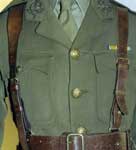
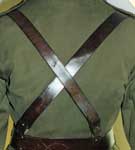
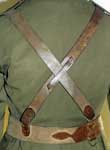 The nomenclature is unusual, not to say perverse, when elsewhere such things are Braces. These were parallel-sided, 1½-inches wide, with the rear ends tapered down slightly to fit the rear Belt dees. Two punched holes allowed the end to be doubled inwards through the dee. In the manner of shirt cuff links, a stud passed through both holes, securing the Brace. The Braces are in two parts, the Dress Regulations terming the secondary component as Chapes, with stud and buckle. In 1919, LoC 21689 used the term Buckling piece instead. At their upper ends a single buckle, with tongue connected to the tapered-down running end of the Brace. The lower end was fitted-up as the rear of the Brace, doubling inwards, with a stud through both thicknesses. Below the buckle was a fixed loop and a sliding runner. Made in pairs, the left Brace had a crossover loop stitched to the inside face, the stitching slanted to give a “one-way-only” guide to its positioning. The photographs at left show a Mk. II pair of Belts, shoulder. In the picture near left, both the Waist belt and Shoulder belts have been reversed to show the contruction and the crossover loop. From the John Bodsworth Collection.
The nomenclature is unusual, not to say perverse, when elsewhere such things are Braces. These were parallel-sided, 1½-inches wide, with the rear ends tapered down slightly to fit the rear Belt dees. Two punched holes allowed the end to be doubled inwards through the dee. In the manner of shirt cuff links, a stud passed through both holes, securing the Brace. The Braces are in two parts, the Dress Regulations terming the secondary component as Chapes, with stud and buckle. In 1919, LoC 21689 used the term Buckling piece instead. At their upper ends a single buckle, with tongue connected to the tapered-down running end of the Brace. The lower end was fitted-up as the rear of the Brace, doubling inwards, with a stud through both thicknesses. Below the buckle was a fixed loop and a sliding runner. Made in pairs, the left Brace had a crossover loop stitched to the inside face, the stitching slanted to give a “one-way-only” guide to its positioning. The photographs at left show a Mk. II pair of Belts, shoulder. In the picture near left, both the Waist belt and Shoulder belts have been reversed to show the contruction and the crossover loop. From the John Bodsworth Collection.
Photographic evidence shows that the inward turns of the Brace ends had already been reversed by 1900. The studs were now “captive”, sandwiched between the Brace and a billet stitched onto the ends of both the Brace and Buckling piece. This latter was reversed so that, when fastened, the chromed face was visible. This became the characteristic fastening, the original reversed form becoming a regimental variation. This seems not to have been the subject of an LoC.
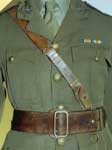 The Buckling piece was considered to be part of the Shoulder Belt (i.e. Brace), so received no separate listing. When the Mark II was sealed, in 1902, to set the design for new manufacture, the Mark I became obsolescent. It was still listed at this status in 1920, but had quietly disappeared by 1924.
The Buckling piece was considered to be part of the Shoulder Belt (i.e. Brace), so received no separate listing. When the Mark II was sealed, in 1902, to set the design for new manufacture, the Mark I became obsolescent. It was still listed at this status in 1920, but had quietly disappeared by 1924.
The “…lighter materials…” referred to in LoC 12267 make this difficult to identify but, unstated until the 1934 Dress Regulations, was that it was also reduced in width to 1¼ inches. The change to captive studs on Brace and Buckling Piece was also incorporated in Mark II Braces. The word “brown” vanished from both Marks between 1915 and 1920, without documentation and later than the Waist belt. In November 1918, LoC 21689 authorized the separation of the pairs of left and right Braces. The left Braces (with crossover loop) were to be issued in lieu of those without loops, until the stock had been used up. Though not stated, no more looped Braces were to be made. As with the Waist belt, minor changes to the syntax gave the new nomenclature of Belt, shoulder, sword, Sam Browne, Mark II. An example of the single Shoulder belt in use is shown at left. From the John Bodsworth Collection. All photographs above © John Bodsworth 2010.
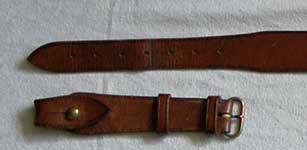 In 1924, LoC A 3, removed the Mark II designation from the nomenclature. The quotation marks having been removed by LoC 21689 in 1918, they now suddenly reappeared, both in the Old and New Designations, though not in the Vocabularies. The Mark II example shown left is from th eRog Dennis Collection, photograph © Rog Dennis 2010.
In 1924, LoC A 3, removed the Mark II designation from the nomenclature. The quotation marks having been removed by LoC 21689 in 1918, they now suddenly reappeared, both in the Old and New Designations, though not in the Vocabularies. The Mark II example shown left is from th eRog Dennis Collection, photograph © Rog Dennis 2010.
For LoC C 4686, reference should be made to the Waist Belt above.
Belts, shoulder, brown, sword, “Sam Browne.” – Variants
Early Braces were over 2-inches wide, reduced to 1½-inches in 1900, but some were even narrower. The first variation has been described under Mark II above, as this became the standard, except for regimental variations that retained the older inwards doubling method. The commonest variant had a small dee on a chape, stitched at the front shoulder, to which a lanyard for a whistle was attached, either permanently, or not. Further down, a closed-bottom sleeve formed stowage for the whistle. A few Braces, when worn singly over the right shoulder, had a series of bullet loops stitched on the front section. Others had small dees on chapes, behind the shoulders, to which the rolled Great coat could be attached. One unique example, in the Regiments of Gloucester Museum, U.K., has a large and leather covered ring in the small of the back. Permanently attached chapes attach to the rear of the belt. Above the ring, the Shoulder belts have two dees on chapes, stitched at angles to the centre-line of the Brace. Thus paired, vertically, they served to accommodate Great coat straps.
Other variations concern the buckle, which divide into two groups – single buckles and double buckles being the nomenclatures. In the single form, the tongue is on one side of an open frame, whereas the double has a central tongue bar. Singles came as oval, or semi-circular and even square. Doubles, of rectangular, sharp-cornered form, were a regimental variation amongst certain cavalry regiments, plus one infantry.
© R.J. Dennis July 2010